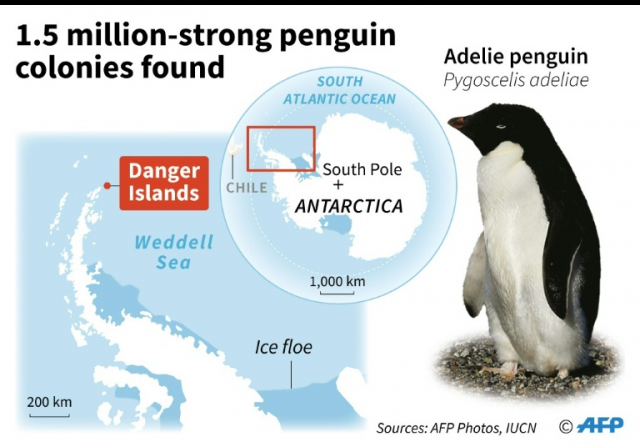
There has been a surprise discovery of 1.5 million Adelie penguins on the remote Danger Islands in east Antarctica. Image: Sophie RAMIS – AFP
A thriving “hotspot” of 1.5 million Adelie penguins, a species fast declining in parts of the world, has been discovered on remote islands off the Antarctic Peninsula, surprised scientists said Friday.
The first bird census of the Danger Islands unearthed over 750,000 Adelie breeding pairs, more than the rest of the area combined, the team reported in the journal Scientific Reports.
In the west Antarctic, Adelie penguins are in decline due to sea ice melt blamed on global warming. Image: MARK RALSTON – AFP/File
The group of nine rocky islands, which lie off the northern tip nearest South America, in the northwest Weddell Sea, housed the third- and fourth-largest Adelie penguin colonies in the world, they found.
“It is certainly surprising and it has real consequences for how we manage this region,” study co-author Heather Lynch of Stony Brook University told AFP.
Just 160 kilometers (100 miles) away on the west of the peninsula — a thin limb jutting out of West Antarctica — Adelie numbers have dropped about 70 percent in recent decades due to sea ice melt blamed on global warming.
“One of the ways in which this is good news is that other studies have shown this area (the eastern side of the Antarctic Peninsula) is likely to remain more stable under climate change than the western Antarctic Peninsula,” said Lynch.
“So we end up with a large population of Adelie penguins in a region likely to remain suitable to them for some time.”
Adelies are one of five penguin species that live in and around the Antarctic continent.
A medium-sized penguin, they grow to about 70 centimeters (almost 28 inches) tall, and weigh three to six kilograms (about seven to 13 pounds). They are identified by a white ring around the eye.
They are carnivores, and krill — shrimp-like creatures that are commercially fished in the area — is an Adelie staple.
The Danger Islands group was discovered thanks to Earth-monitoring satellites, said the research team from America, Britain and France.
“This is called the Danger Islands for a reason,” said Lynch.
“The area is covered by heavy sea ice most of the year, and even in the height of summer it is difficult to get into this region to do surveys.”
‘Very lucky’
Even the most visited of the isles, Heroina Island at the chain’s northeastern tip, receives only about one ship landing per year.
Evidence of the previously-unknown penguin colony first emerged in data from the Landsat Earth-monitoring satellites run by NASA and the US Geological Survey.
Lynch and her team “then went and looked at higher resolution commercial imagery to confirm the guano staining that our algorithms had picked up in the Landsat imagery,” she said.
When the Landsat data originally suggested the presence of hundreds of thousands of penguins on the islands, she thought it “was a mistake”.
“We were surprised to find so many penguins on these islands, especially because some of these islands were not known to have penguins.”
This handout photo released by WHOI/MIT shows an aerial view of an Adelie penguin breeding colony on the Danger Islands. Image: Thomas Sayre-McCord – WHOI/MIT/AFP
Then followed a field expedition for a census using a combination of drone footage, pictures taken on the ground, and an old-fashioned walk-about headcount.
“We were… very lucky to have a window of time where the sea ice moved out and we could get a yacht in,” said Lynch.
The Danger Islands, said the team, has felt the ravages of climate change less than the western peninsula, and knew very little human activity.
Now it turns out, the area may need stronger protection from overfishing.
“The most important implication of this work is related to the design of Marine Protected Areas in the region,” said Lynch.
“Now that we know this tiny island group is so important, it can be considered for further protection from fishing.”
In addition to Adelies, the team also found about 100 nests of gentoo penguins and about 27 nests of chinstrap penguins.
The polar regions are warming more rapidly than the rest of Earth as heat-trapping greenhouse gasses from fossil fuel-burning build up in the atmosphere. NVG
RELATED STORIES:
Chile penguins win battle in war against mine
Abundant fish draw 1 million penguins to Argentine peninsula